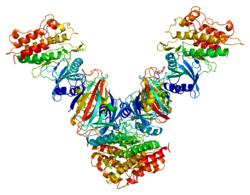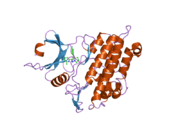TGFBR1
Beta receptor I transformirajućeg faktora rasta (aktivinski receptor A tipa sličnog kunazi II, 53kDa) je membranski vezani TGF-beta receptorski protein porodice receptora TGF-beta za superporodicu signalnih liganda TGF-beta. TGFBR1 je njegov ljudski gen.
Aminokiselinska sekvenca
[uredi | uredi izvor]Dužina polipeptidnog lanca je 503 aminokiseline, а molekulska težina Da. 55 960[5]
| 10 | 20 | 30 | 40 | 50 | ||||
|---|---|---|---|---|---|---|---|---|
| MEAAVAAPRP | RLLLLVLAAA | AAAAAALLPG | ATALQCFCHL | CTKDNFTCVT | ||||
| DGLCFVSVTE | TTDKVIHNSM | CIAEIDLIPR | DRPFVCAPSS | KTGSVTTTYC | ||||
| CNQDHCNKIE | LPTTVKSSPG | LGPVELAAVI | AGPVCFVCIS | LMLMVYICHN | ||||
| RTVIHHRVPN | EEDPSLDRPF | ISEGTTLKDL | IYDMTTSGSG | SGLPLLVQRT | ||||
| IARTIVLQES | IGKGRFGEVW | RGKWRGEEVA | VKIFSSREER | SWFREAEIYQ | ||||
| TVMLRHENIL | GFIAADNKDN | GTWTQLWLVS | DYHEHGSLFD | YLNRYTVTVE | ||||
| GMIKLALSTA | SGLAHLHMEI | VGTQGKPAIA | HRDLKSKNIL | VKKNGTCCIA | ||||
| DLGLAVRHDS | ATDTIDIAPN | HRVGTKRYMA | PEVLDDSINM | KHFESFKRAD | ||||
| IYAMGLVFWE | IARRCSIGGI | HEDYQLPYYD | LVPSDPSVEE | MRKVVCEQKL | ||||
| RPNIPNRWQS | CEALRVMAKI | MRECWYANGA | ARLTALRIKK | TLSQLSQQEG | ||||
| IKM |
Funkcija
[uredi | uredi izvor]Protein kodiran ovim genom formira heteromerni kompleks sa tipom II TGF-β receptora kada je vezan za TGF-β, transducirajući signal TGF-β sa ćelijske površine na citoplazmu. Kodirani protein je serin/treonin protein kinaza. Mutacije u ovom genu povezane su s sindromom Loeys – Dietzove aortne aneurizme (LDS, LDAS).[6]
Interakcije
[uredi | uredi izvor]Pokazalo se da TGF beta receptor 1 stupa u interakciju skako slijedi:
Inhibitori
[uredi | uredi izvor]- GW-788,388
- LY-2109761
- Galunisertib (LY-2157299)
- SB-431,542
- SB-525,334
Studije na životinjama
[uredi | uredi izvor]Defekti se primjećuju kada je gen TGFBR-1 ili nokautiran ili kada je konstitutivno aktivan mutant TGFBR-1 (koji je aktivan u prisustvu ili odsustvu liganda)
U mišjim nokaut TGFBR-1 modelima, ženke bile su sterilne. Razvili su oviduktne divertikule i neispravan glatki mišić maternice, što znači da su slojevi glatkih mišića maternice bili slabo formirani. Oviduktni divertikule su male, ispupčene vrećice smještene na jajovodu, koji je cijev koja prenosi jajnu ćeliju iz jajnika u maternicu. Ova deformacija jajovoda nastala je obostrano i rezultirala je smanjenim razvojem embriona i njegovim otežanim prolaskom u maternicu. Ovulacija i oplodnja su se još dogoađale u nokautima, ali ostaci embriona pronađeni su u ovim oviduktnim divertikulama.[25]
Kod mišjih TGFBR-1 nock-in modela u kojima je konstitutivno aktivni gen TGFBR-1 uvjetno induciran, prekomjerna aktivacija receptora TGFBR-1 dovodi do neplodnosti, smanjenja broja žlijezda materice i hipermišićavih maternica (povećanje količina glatkih mišića u maternici).[26]
Ovi eksperimenti pokazuju da receptor TGFB-1 ima kritičnu ulogu u funkciji ženskog reproduktivnog trakta. Oni također pokazuju da genetičke mutacije u genu TGFBR-1 mogu dovesti do problema s plodnošću kod žena.
Reference
[uredi | uredi izvor]- ^ a b c GRCh38: Ensembl release 89: ENSG00000106799 - Ensembl, maj 2017
- ^ a b c GRCm38: Ensembl release 89: ENSMUSG00000007613 - Ensembl, maj 2017
- ^ "Human PubMed Reference:". National Center for Biotechnology Information, U.S. National Library of Medicine.
- ^ "Mouse PubMed Reference:". National Center for Biotechnology Information, U.S. National Library of Medicine.
- ^ "UniProt, P36897". Pristupljeno 12. 9. 2021.
- ^ "Entrez Gene: TGFBR1 transforming growth factor, beta receptor I (activin A receptor type II-like kinase, 53kDa)".
- ^ a b Razani B, Zhang XL, Bitzer M, von Gersdorff G, Böttinger EP, Lisanti MP (mart 2001). "Caveolin-1 regulates transforming growth factor (TGF)-beta/SMAD signaling through an interaction with the TGF-beta type I receptor". The Journal of Biological Chemistry. 276 (9): 6727–38. doi:10.1074/jbc.M008340200. PMID 11102446.
- ^ Guerrero-Esteo M, Sanchez-Elsner T, Letamendia A, Bernabeu C (august 2002). "Extracellular and cytoplasmic domains of endoglin interact with the transforming growth factor-beta receptors I and II". The Journal of Biological Chemistry. 277 (32): 29197–209. doi:10.1074/jbc.M111991200. PMID 12015308.
- ^ Barbara NP, Wrana JL, Letarte M (januar 1999). "Endoglin is an accessory protein that interacts with the signaling receptor complex of multiple members of the transforming growth factor-beta superfamily". The Journal of Biological Chemistry. 274 (2): 584–94. doi:10.1074/jbc.274.2.584. PMID 9872992.
- ^ Wang T, Donahoe PK, Zervos AS (juli 1994). "Specific interaction of type I receptors of the TGF-beta family with the immunophilin FKBP-12". Science. 265 (5172): 674–6. doi:10.1126/science.7518616. PMID 7518616.
- ^ Liu F, Ventura F, Doody J, Massagué J (juli 1995). "Human type II receptor for bone morphogenic proteins (BMPs): extension of the two-kinase receptor model to the BMPs". Molecular and Cellular Biology. 15 (7): 3479–86. doi:10.1128/mcb.15.7.3479. PMC 230584. PMID 7791754.
- ^ Kawabata M, Imamura T, Miyazono K, Engel ME, Moses HL (decembar 1995). "Interaction of the transforming growth factor-beta type I receptor with farnesyl-protein transferase-alpha". The Journal of Biological Chemistry. 270 (50): 29628–31. doi:10.1074/jbc.270.50.29628. PMID 8530343.
- ^ Wrighton KH, Lin X, Feng XH (juli 2008). "Critical regulation of TGFbeta signaling by Hsp90". Proceedings of the National Academy of Sciences of the United States of America. 105 (27): 9244–9. doi:10.1073/pnas.0800163105. PMC 2453700. PMID 18591668.
- ^ Mochizuki T, Miyazaki H, Hara T, Furuya T, Imamura T, Watabe T, Miyazono K (juli 2004). "Roles for the MH2 domain of Smad7 in the specific inhibition of transforming growth factor-beta superfamily signaling". The Journal of Biological Chemistry. 279 (30): 31568–74. doi:10.1074/jbc.M313977200. PMID 15148321.
- ^ Asano Y, Ihn H, Yamane K, Kubo M, Tamaki K (januar 2004). "Impaired Smad7-Smurf-mediated negative regulation of TGF-beta signaling in scleroderma fibroblasts". The Journal of Clinical Investigation. 113 (2): 253–64. doi:10.1172/JCI16269. PMC 310747. PMID 14722617.
- ^ Koinuma D, Shinozaki M, Komuro A, Goto K, Saitoh M, Hanyu A, Ebina M, Nukiwa T, Miyazawa K, Imamura T, Miyazono K (decembar 2003). "Arkadia amplifies TGF-beta superfamily signalling through degradation of Smad7". The EMBO Journal. 22 (24): 6458–70. doi:10.1093/emboj/cdg632. PMC 291827. PMID 14657019.
- ^ Kavsak P, Rasmussen RK, Causing CG, Bonni S, Zhu H, Thomsen GH, Wrana JL (decembar 2000). "Smad7 binds to Smurf2 to form an E3 ubiquitin ligase that targets the TGF beta receptor for degradation". Molecular Cell. 6 (6): 1365–75. doi:10.1016/s1097-2765(00)00134-9. PMID 11163210.
- ^ Hayashi H, Abdollah S, Qiu Y, Cai J, Xu YY, Grinnell BW, Richardson MA, Topper JN, Gimbrone MA, Wrana JL, Falb D (juni 1997). "The MAD-related protein Smad7 associates with the TGFbeta receptor and functions as an antagonist of TGFbeta signaling". Cell. 89 (7): 1165–73. doi:10.1016/s0092-8674(00)80303-7. PMID 9215638. S2CID 16552782.
- ^ a b Datta PK, Moses HL (maj 2000). "STRAP and Smad7 synergize in the inhibition of transforming growth factor beta signaling". Molecular and Cellular Biology. 20 (9): 3157–67. doi:10.1128/mcb.20.9.3157-3167.2000. PMC 85610. PMID 10757800.
- ^ Griswold-Prenner I, Kamibayashi C, Maruoka EM, Mumby MC, Derynck R (novembar 1998). "Physical and functional interactions between type I transforming growth factor beta receptors and Balpha, a WD-40 repeat subunit of phosphatase 2A". Molecular and Cellular Biology. 18 (11): 6595–604. doi:10.1128/mcb.18.11.6595. PMC 109244. PMID 9774674.
- ^ Datta PK, Chytil A, Gorska AE, Moses HL (decembar 1998). "Identification of STRAP, a novel WD domain protein in transforming growth factor-beta signaling". The Journal of Biological Chemistry. 273 (52): 34671–4. doi:10.1074/jbc.273.52.34671. PMID 9856985.
- ^ Ebner R, Chen RH, Lawler S, Zioncheck T, Derynck R (novembar 1993). "Determination of type I receptor specificity by the type II receptors for TGF-beta or activin". Science. 262 (5135): 900–2. doi:10.1126/science.8235612. PMID 8235612.
- ^ Oh SP, Seki T, Goss KA, Imamura T, Yi Y, Donahoe PK, Li L, Miyazono K, ten Dijke P, Kim S, Li E (mart 2000). "Activin receptor-like kinase 1 modulates transforming growth factor-beta 1 signaling in the regulation of angiogenesis". Proceedings of the National Academy of Sciences of the United States of America. 97 (6): 2626–31. doi:10.1073/pnas.97.6.2626. PMC 15979. PMID 10716993.
- ^ Kawabata M, Chytil A, Moses HL (mart 1995). "Cloning of a novel type II serine/threonine kinase receptor through interaction with the type I transforming growth factor-beta receptor". The Journal of Biological Chemistry. 270 (10): 5625–30. doi:10.1074/jbc.270.10.5625. PMID 7890683.
- ^ Li Q, Agno JE, Edson MA, Nagaraja AK, Nagashima T, Matzuk MM (oktobar 2011). "Transforming growth factor β receptor type 1 is essential for female reproductive tract integrity and function". PLOS Genetics. 7 (10): e1002320. doi:10.1371/journal.pgen.1002320. PMC 3197682. PMID 22028666.
- ^ Gao Y, Duran S, Lydon JP, DeMayo FJ, Burghardt RC, Bayless KJ, Bartholin L, Li Q (februar 2015). "Constitutive activation of transforming growth factor Beta receptor 1 in the mouse uterus impairs uterine morphology and function". Biology of Reproduction. 92 (2): 34. doi:10.1095/biolreprod.114.125146. PMC 4435420. PMID 25505200.
Dopunska literatura
[uredi | uredi izvor]- Massagué J (juni 1992). "Receptors for the TGF-beta family". Cell. 69 (7): 1067–70. doi:10.1016/0092-8674(92)90627-O. PMID 1319842. S2CID 54268875.
- Wrana JL (1998). "TGF-beta receptors and signalling mechanisms". Mineral and Electrolyte Metabolism. 24 (2–3): 120–30. doi:10.1159/000057359. PMID 9525694. S2CID 84458561.
- Josso N, di Clemente N, Gouédard L (juni 2001). "Anti-Müllerian hormone and its receptors". Molecular and Cellular Endocrinology. 179 (1–2): 25–32. doi:10.1016/S0303-7207(01)00467-1. PMID 11420127. S2CID 27316217.
Vanjski linkovi
[uredi | uredi izvor]- GeneReviews/NIH/NCBI/UW entry on Thoracic Aortic Aneurysms and Aortic Dissections
- GeneReviews/NCBI/NIH/UW entry on Loeys-Dietz Syndrome










